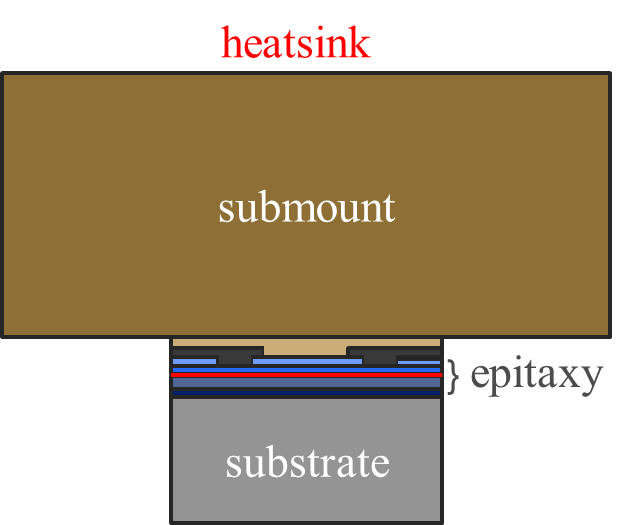AMaSiS 2018 Workshop: Abstracts
Traveling wave simulations of broad-area lasers
Anissa Zeghuzi, Mindaugas Radziunas, Hans Wenzel, Hans-Jürgen Wünsche, Jan-Philipp Koester, Uwe Bandelow, and Andrea Knigge
(1) Ferdinand-Braun-Institut, Leibniz Institut für Höchstfrequenztechnik (FBH), Berlin
(2) Weierstrass Institute für Angewandte Analysis und Stochastik (WIAS), Berlin
High-power broad-area diode lasers (BALs) emitting extremely high powers despite their small device sizes of only milimeters find more and more important applications. Due to their intrinsically non-stationary behavior [1], the electro-optical-thermal characteristics of BALs have to be simulated on the basis of a time and space dependent model, which is espacially challenging due to the very different time and 3-dimensional length scales involved (see Fig. 1).

Fig 1: Schematic representation of the total travensveral cross-
section of the simulation area including submount with attached heat sink.
The most recent version of the software tool BALaser [2] based on a time-dependent traveling wave model, meets all these requirements. It properly describes the injected current density into and the diffusion of the carriers within the active region. Furthermore the model takes into account the heat flow within the device by iterative coupling of the dynamic electro-optical and a static heat flow model [3] that calculates temperature and thermally-induced refractive index changes (thermal lens) within the active region.
We discuss the relation of this model to other models from literature and give an overview over its first applications to realistic BAL structures as fabricated in FBH, for both pulsed and continuous wave operation. The influence of non-thermal gain saturation effects are studied, which are important for pulsed operation. Furthermore effects of the spatio-temporal dynamics are discussed and thermal and non-thermal (carrier transport related) far-field blooming is analyzed and optimized with respect to applications by varying the device structure.
Acknowledgments: This work is supported by the German Federal Ministry of Education and Research contract 13N14005 and 13N14026 as part of the EffiLAS/HotLas and EffiLAS/PLuS project.
References
- 1 A. Klehr, A. Liero, H. Wenzel, A. Zeghuzi, J. Fricke, R. Staske, and A. Knigge, “Pico- and nanosecond investigations of the lateral nearfield of broad area lasers under pulsed high-current excitation”, Proc. SPIE 10553, 105530K (2018).
- 2 BALaser, “A software tool for simulation of dynamics in broad area semiconductor lasers.” http://www.wias-berlin.de/software/balaser/.
- 3 M. Radziunas, J. Fuhrmann, A. Zeghuzi, H.-J. Wünsche, Th. Koprucki, H. Wenzel, and U. Bandelow, “Efficient coupling of heat-flow and electro-optical models for simulation of dynamics in high-power broad-area semiconductor lasers”, Proc. NUSOD 18 (2018) - to be published.